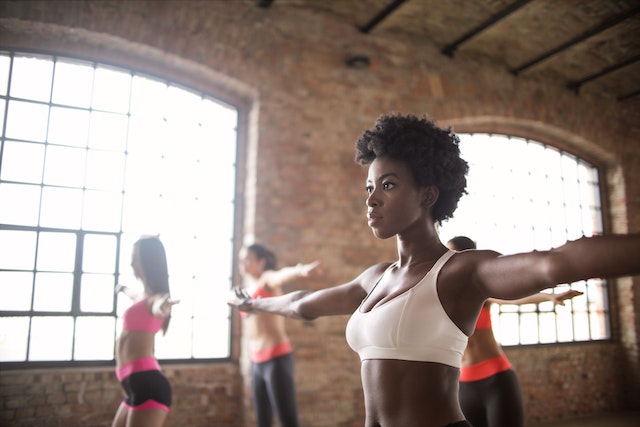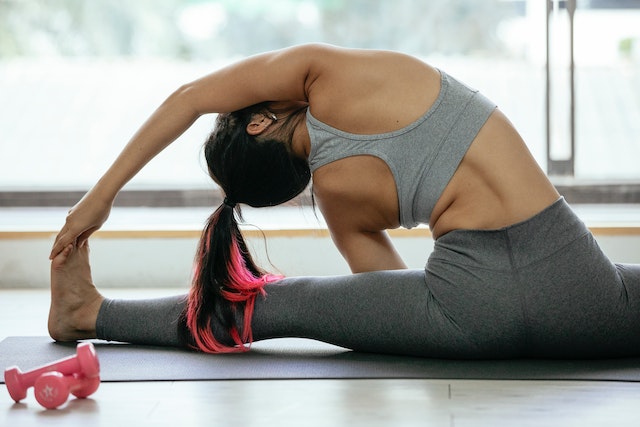
Warming up prepares your body for exercise by increasing blood flow to your muscles, which helps your muscles perform better. Cooling down helps prevent muscle soreness and injury and reduces your risk of cardiovascular problems.
Warm-Up Benefits Before Workout
Warm-up exercises can be divided into “static” and “dynamic.” Static warm-ups focus on stretching and strengthening muscles without using momentum to perform movements. Dynamic warm-ups involve stretching, strengthening, and aerobic activity all at once.
Here are some significant benefits of doing warm-ups before diving into an intense exercise routine:
1. Increases Flexibility & Blood Flow
One of the most important benefits of doing a proper warm-up is increased flexibility. As we grow older, our joints become stiffer, making it difficult for us to bend them at various angles. However, this stiffness can be significantly reduced if we start regular warm-up exercises. It will allow us to move freely and perform various activities without problems.
Another essential benefit of warm-up exercises before working out is increased blood flow to muscles which helps in better circulation and nutrient delivery to those tissues. It improves performance during workouts, reduces the risk of injury during exercise, and enables faster recovery after workouts.
2. Muscle Contraction & Relaxation Is Faster (Prevents Soreness, Fatigue, and Stiffness)
Warm-ups increase body temperature and prepare the muscles and joints for strenuous activity. It also increases the heart rate, which helps more blood flow to the muscles. It improves your muscle tone, strength, flexibility, and balance.
Additionally, warm-ups that prevent muscle cramping are essential when doing any strenuous exercise because they help prevent muscles from getting weary and stiff. Without warming up before exercising, there is a higher chance that your muscles will become strained or torn due to sudden movements or heavy lifting.

3. Decreases Stress & Anxiety Instantly
When you do warm-up exercises, you instantly reduce the stress in your body and mind. You will not feel anxious or tense while doing these exercises because they make you feel relaxed and calm you down instantly.
Stress and exercise are related because they affect the body differently. Stress can be mental or physical; you start feeling exhausted when your body experiences stress. The movement also causes stress on the body resulting in fatigue and exhaustion.
Warm-up exercises help relieve mental stress by enhancing blood flow and increasing oxygen supply to your brain, which helps in clearing out fatigue and tiredness, thus allowing you to sleep better. These exercises also ensure that your muscles are ready for the upcoming physical activity and assist them in adapting accordingly.
4. Increased Oxygen Efficiency in Body Prevents Injury
As we know, our body temperature falls after a long rest or sleep. So when we wake up, our body starts heating up slowly. This process takes time; hence, we feel cold for some time after waking up. During this process, our muscles also get cold and stiff, which makes them weak to perform any activity efficiently. So for warming up muscles, several exercises are required to gradually increase the body temperature and make them ready for a workout.
Blood is vital for muscle contraction and relaxation during workouts because it carries oxygen from the heart to muscles via the circulatory system (arteries). If there is less amount of blood available in muscles, then it won’t be able to get enough oxygen from the heart, so it will not be able to perform well at all, thus increasing the risk of injury. That’s why warm-up exercises are essential.
5. Better Metabolism
Warm-ups increase your metabolism, which results in burning more calories throughout the day even when you are not exercising. It can be helpful if you are trying to lose weight or tone up specific body parts such as your abs or thighs.

Cooldown Benefits After Workout
To get the most out of your workout without hurting yourself, you must take time off from exercising after each session so that your body can heal properly before the next one.
Cooldown is the part of your workout where you slowly transition from active exercise to a period of rest and recovery. The reason for this transition is that it allows your body to regulate its temperature, which can help prevent heat-related illnesses such as heatstroke and dehydration.
Here are some significant benefits of cooldowns after finishing an intense exercise session:
1. Removal of Lactic Acid
Lactic acid is a byproduct of anaerobic metabolism that causes muscle soreness and fatigue during exercise. A cooldown allows your body to flush out lactic acid from muscles into circulation so that it can be eliminated through urination or breathing.
2. Reduction in DOMS (Delayed Onset Muscle Soreness)
After a workout, you may experience muscle soreness and stiffness. It is called delayed onset muscle soreness (DOMS). It is often felt 24-72 hours after exercise and can last for a few days.
Cooling down after a workout helps reduce DOMS by enhancing blood flow to the muscles and removing waste products from them.
3. Allows Your Heart Rate to Return to Normal
When you start exercising, your heart rate and blood pressure rise. It causes more blood to flow through your veins and arteries to supply oxygen to your muscles as needed during exercise. When you stop exercising, your heart rate returns to normal, but your blood pressure remains higher for some time because more blood flows through your veins than usual.
Cooling down helps bring back the circulation rate to normal within minutes of stopping exercising, which minimizes blood clotting or excessive strain on the walls of blood vessels in case they have been damaged during exercise due to over-exertion or dehydration.
Final Words
It’s great that many fitness fanatics, from professional athletes to eager gym-goers alike, are aware of the health benefits of warming up and cooling down before and after workouts. But in addition to the physical benefits, warm-ups and cooldowns also bring psychological benefits. These exercises prepare you physically and mentally for the activities ahead and put you into a calmer state after a workout has finished by restoring peace on the inside and slowing down your heart rate.





Leave a reply